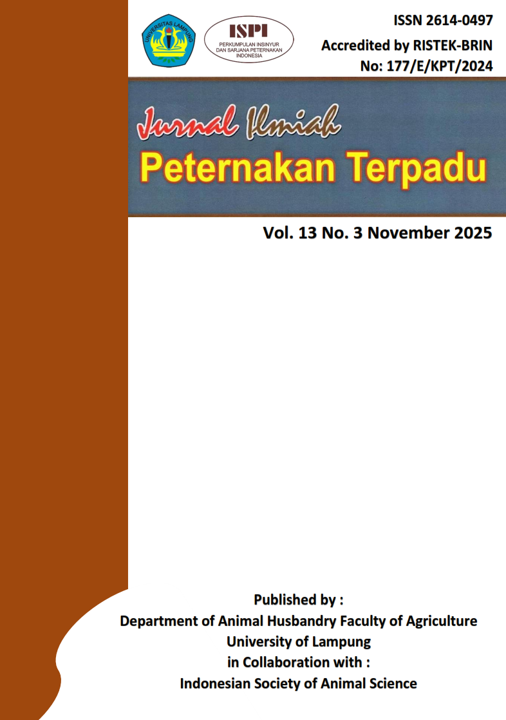Effect of Macronutrient Feed Combinations on Bioconversion, Survival, Growth, and Nutritional Value of Hermetia illucens Larvae
DOI:
https://doi.org/10.23960/jipt.v13i3.p816-831 Abstract View: 47
Abstract View: 47
Keywords:
Proximate Content Survival rate Bioconversion GrowthAbstract
Organic wastes of tilapia offal, coconut pulp, and plantain are rarely optimally utilized, but they can be degraded by BSF larvae into nutritious biomass. This study aims to analyze the combination of organic waste macronutrient feed on bioconversion, survival, growth (weight, length, and thickness), and nutritional value (protein, fat, and carbohydrates) of BSF prepupae, using the Completely Randomized Design (CRD) method, 4 treatments P1 (50% tilapia offal: 25% plantain: 25% coconut pulp), P2 (25% tilapia offal: 50% plantain: 25% coconut pulp), P3 (25% tilapia offal: 25% plantain: 50% coconut pulp), P4 (33.3% tilapia offal: 33.3% plantain: 33.3% coconut pulp) and 3 repetitions. All treatments resulted in optimal survival (100%, survival). P4 produced an ECD value of 0.034% and WRI of 0.032% indicating the best efficiency and waste reduction. P1 was the best variation for weight at 5.69 g, length 19.7 mm, and thickness 5.8 mm. The Post Hoc Tuckey test showed no significant difference between treatments in weight and thickness parameters, but not in length parameters (<0.05). The protein content of P1 43.75%, fat P2 29.764%, and carbohydrate P2 1.374% were close to SNI 7994:2014 (meat bone meal, quality II). It was concluded that macronutrient feed waste affects bioconversion, survival, growth and nutritional value of BSF.
Downloads
Downloads
Published
How to Cite
Issue
Section
License
Copyright (c) 2025 Fitria Sagita

This work is licensed under a Creative Commons Attribution 4.0 International License.

Jurnal Ilmiah Peternakan Terpadu(JIPT) is licensed under a Creative Commons Attribution 4.0 International License.
Authors who publish with this journal agree to the following terms:
- Authors retain copyright and grant the journal right of first publication with the work simultaneously licensed under a Creative Commons Attribution License that allows others to share the work with an acknowledgement of the work's authorship and initial publication in this journal.
- Authors are able to enter into separate, additional contractual arrangements for the non-exclusive distribution of the journal's published version of the work (e.g., post it to an institutional repository or publish it in a book), with an acknowledgement of its initial publication in this journal.
- Authors are permitted and encouraged to post their work online (e.g., in institutional repositories or on their website) prior to and during the submission process, as it can lead to productive exchanges, as well as earlier and greater citation of published work (See The Effect of Open Access).





















